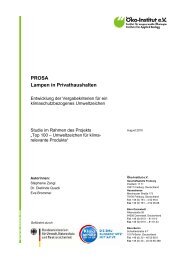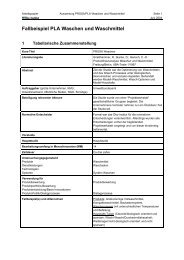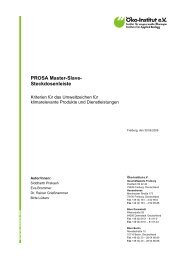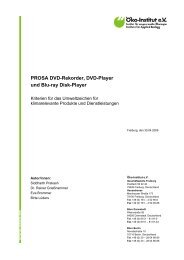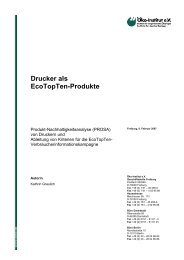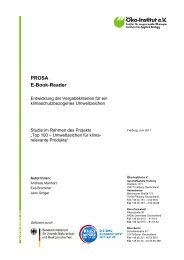PROSA – Product Sustainability Assessment - PROSA - Produkt ...
PROSA – Product Sustainability Assessment - PROSA - Produkt ...
PROSA – Product Sustainability Assessment - PROSA - Produkt ...
Sie wollen auch ein ePaper? Erhöhen Sie die Reichweite Ihrer Titel.
YUMPU macht aus Druck-PDFs automatisch weboptimierte ePaper, die Google liebt.
<strong>PROSA</strong> <strong>Product</strong> <strong>Sustainability</strong> <strong>Assessment</strong><br />
Furthermore, big companies have to fear the risk of loosing their good brand name<br />
reputation. Engaging in corruption is therefore a much bigger risk for big companies than for<br />
small enterprises.<br />
Although one may argue, that systematic case documentation is improving, a comprehensive<br />
list of cases is not foreseeable: Even if all corruption news from minor newspapers would be<br />
included, there are still a vast amount of revealed corruption cases that never entered news<br />
reporting at all and that are only documented in the according court documents.<br />
Furthermore this indicator is also limited, since most corruption cases are never revealed at<br />
all.<br />
Indicator 2: „Programmes and policies to prevent corruption“<br />
In a similar form, this indicator was proposed by the OECD Guidelines for Multinational<br />
Enterprises and the <strong>Sustainability</strong> Reporting Guidelines (2002 Version) and provides an<br />
easy-to-measure tool. Nevertheless recent developments (<strong>Sustainability</strong> Reporting<br />
Guidelines Version 2006) mark a shift away from this kind of indicators, since policies and<br />
programmes do not necessarily correlate with actual business practices. The current draft<br />
version of the <strong>Sustainability</strong> Reporting Guidelines proposes to use the indicators „extent of<br />
training and risk analysis to prevent corruption“ and „actions taken in response to instances<br />
of corruption“ in sustainability reporting instead. These approaches seem not feasible for<br />
SLCAs for similar reasons.<br />
Indicator 3: International corruption rankings<br />
For several years, Transparency International publishes the annual Corruption Perception<br />
Index, a ranking of countries according to its perceived level of corruption. Although<br />
Transparency International clearly refers to the ranking’s weaknesses, it quickly gained<br />
popularity and is frequently used in many studies to quantify the level of corruption in a<br />
certain location. The reason why the Corruption Perception Index became such a famous<br />
tool is the fact that it provides a simple quantification for the seemingly immeasurable topic of<br />
corruption. For the use in SLCA, such an easy-to-use ranking could also be of great value: If<br />
we would know in which region companies are more prone to corrupt practices, we would<br />
have a base to start from for any further evaluations.<br />
Unfortunately the Corruption Perception Index does not seem to be fully appropriate for<br />
SLCA applications for the following reason: The index measures the public perception of<br />
government corruption. Corruption within the business world and the willingness of<br />
businesses to pay bribes is excluded.<br />
Transparency International developed another index, which has the Potenzial to complement<br />
the Corruption Perception Index for SLCA applications: The Bribe Payers Index is one of the<br />
few approaches to systematically measures corruption in the business world. It surveys the<br />
willingness of multinational companies to pay bribes to high ranking officials in emerging<br />
167



